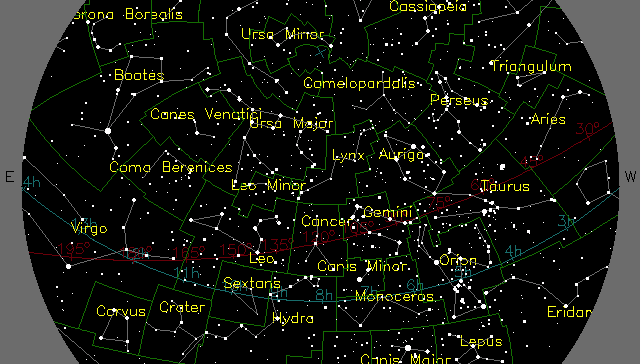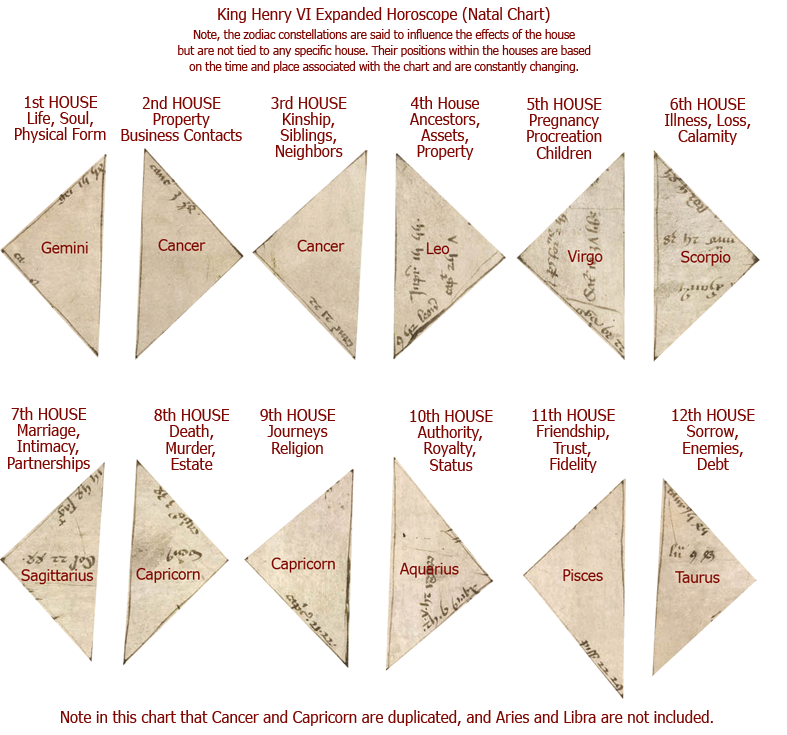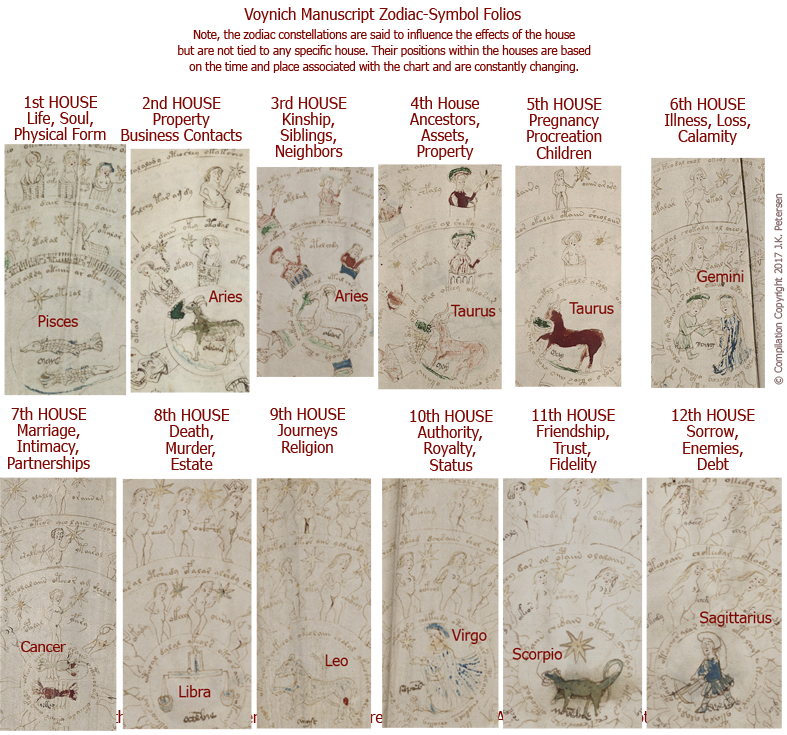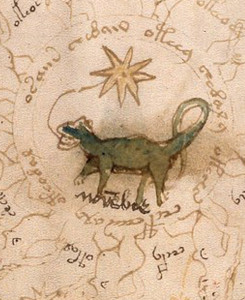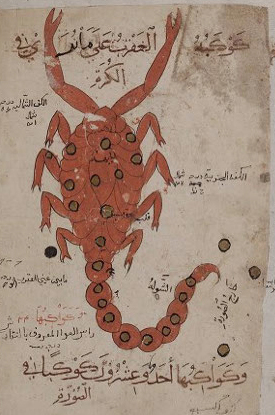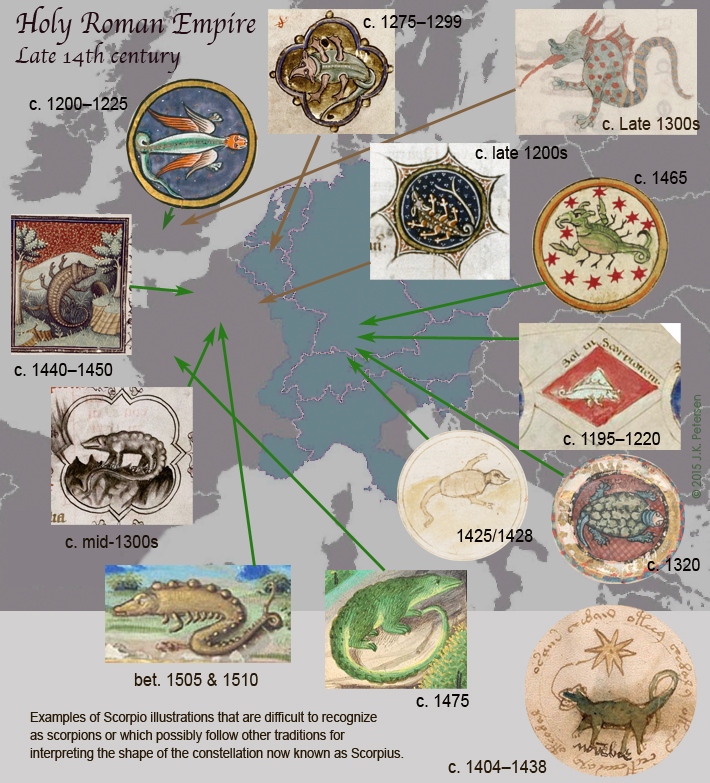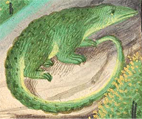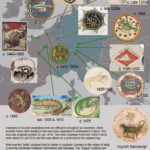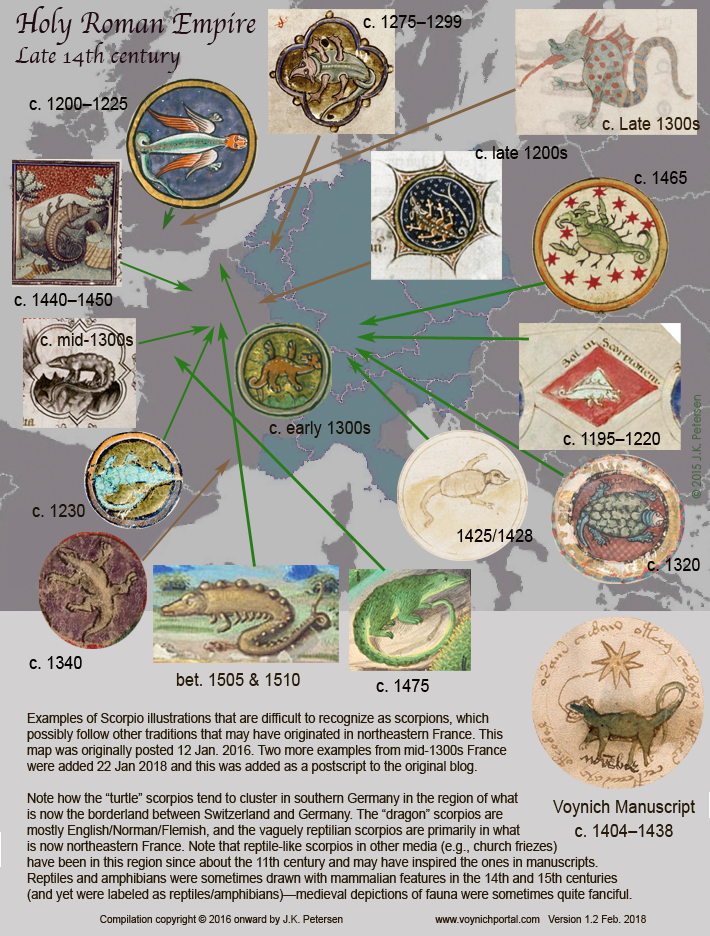In a previous blog I wrote about the VMS cycles of life, the circles of nymphs that surround the zodiac symbols. This blog discusses why there are two zodiac symbols missing, why some of them are paired, and why some of the nymphs are clothed, something I was trying to work out when I wrote the original blog in April 2016.
Mi Casa
The Spaniards are legendary for their hospitality. Mi Casa Es Su Casa is a common expression and I certainly received cheerful greetings everywhere I traveled in Mexico some years ago, even though I was a foreigner who knew nothing of the language. The locals immediately started teaching me Spanish and never frowned or rolled their eyes if I used the wrong word or pronounced it badly. Instead, they cheered my efforts and clapped me on the back for even the smallest effort.
In astrology, things are a little different. My house isn’t necessarily your house. The stars are in different positions every time a child is born, and their relative positions are said to reflect one’s destiny.
Most people are familiar with the zodiac, the twelve symbols that make up a cycle of constellations, but ask them about astrological houses and the majority have no idea what you are talking about.
In a nutshell, in medieval astrology, the heavens were divided into twelve parts, working from east to west and the houses are organized into groups of three, each group having its own general character (masculine, feminine, choleric, melancholic, etc.).
The Twelve Houses
The twelve houses are not the same as the twelve zodiac symbols—even though they are related. In astrological forecasting (horoscopes), the influence of the constellations and planets on a person’s life is based their positions at a specific time and place and this will depend on where they appear in relation to each other in various houses. In other words, a planet can show up in more than one house or not at all, and each planet, in turn, was said to govern specific zodiac symbols. It’s more about influence and the precise position of a constellation in the sky than sequence. A constellation can cross the boundary from one house to the next and thus be attributed to two houses.
The following simulations show the sky above Rome, Italy, courtesy of Fourmilab.ch. I thought this might make it easier to illustrate how the constellations move through successive houses. The red line is the ecliptic, which makes it easier to find the familiar zodiac constellations:
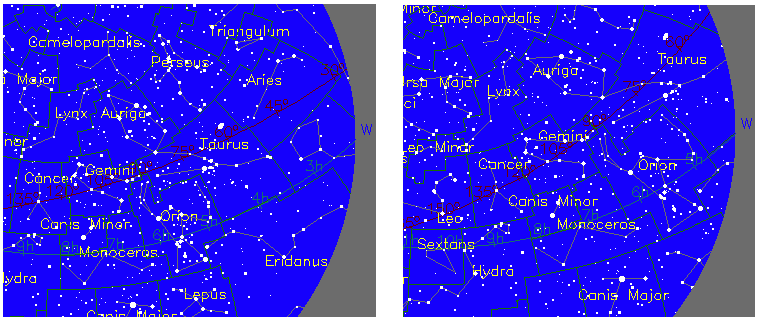 Note how Aries, Taurus, Gemini, and Cancer are related to one another in a curve from top right to middle left. In the second illustration, two hours later, Aries has moved outside our viewport, Taurus has moved close to where Aries was before, but Gemini and Cancer are still somewhat in the middle, a little farther apart (you have to remember that the Earth is round and our drawing is flat). Now imagine a grid with the twelve houses superimposed on this view of the sky and you can imagine how some of the constellations may have crossed a house boundary, some might be in the same house, and some might be in transition from one to the next. Thus, the position of the constellations in the houses is not as rigidly geometric as a zodiac wheel might imply.
Note how Aries, Taurus, Gemini, and Cancer are related to one another in a curve from top right to middle left. In the second illustration, two hours later, Aries has moved outside our viewport, Taurus has moved close to where Aries was before, but Gemini and Cancer are still somewhat in the middle, a little farther apart (you have to remember that the Earth is round and our drawing is flat). Now imagine a grid with the twelve houses superimposed on this view of the sky and you can imagine how some of the constellations may have crossed a house boundary, some might be in the same house, and some might be in transition from one to the next. Thus, the position of the constellations in the houses is not as rigidly geometric as a zodiac wheel might imply.
Medieval Houses in Brief
The houses are somewhat hierarchical and express cycles of human life. Astrologers have given specific significance to each house and those designations have evolved over the centuries, but here is how they were understood in the 11th to 15th centuries:
- The first house governs one’s life, soul, and general physical form.
- The second house relates to one’s household, property, business dealings, and relationships.
- The third house is kinship. It refers to one’s siblings, neighbors, communication, and local travels.
- The fourth house relates to one ancestors, assets, house and land, and local community.
- The fifth house is pregnancy and procreation, children and events in which people come together to celebrate and enjoy one another’s company. In modern astrology, it also relates more broadly to enjoyment and recreation.
- The sixth house refers to illness, calamity, and loss of property in the earlier manuscripts, and to living property, including servants, herd animals, and contractors in later manuscripts. In modern astrology, it relates to nurturance, health and well-being.
- The seventh house relates to marriage, matters of intimate relationships, partnerships, quarrels, lawsuits, agreements, and disputes.
- The eighth house relates to death and murder in earlier manuscripts, and to one’s estate, wills, inheritance, dowries, and other aspects of property in later manuscripts.
- The ninth house relates to journeys and long voyages, and also to philosophy, visions, and matters of religion.
- The tenth house relates to authority, including sultans, kings, dukes, judges, and generals, as well as one’s image and status in society. In modern astrology, it relates to status, career, and ambition.
- The eleventh house is friendship, trust, praise, and fidelity.
- The twelfth house relates to sorrow, enemies, debts, imprisonment, curses, secrets, and mischief. In modern astrology, it relates to clandestine activities, mysteries, privacy, and secrecy.
Medieval Horoscopes
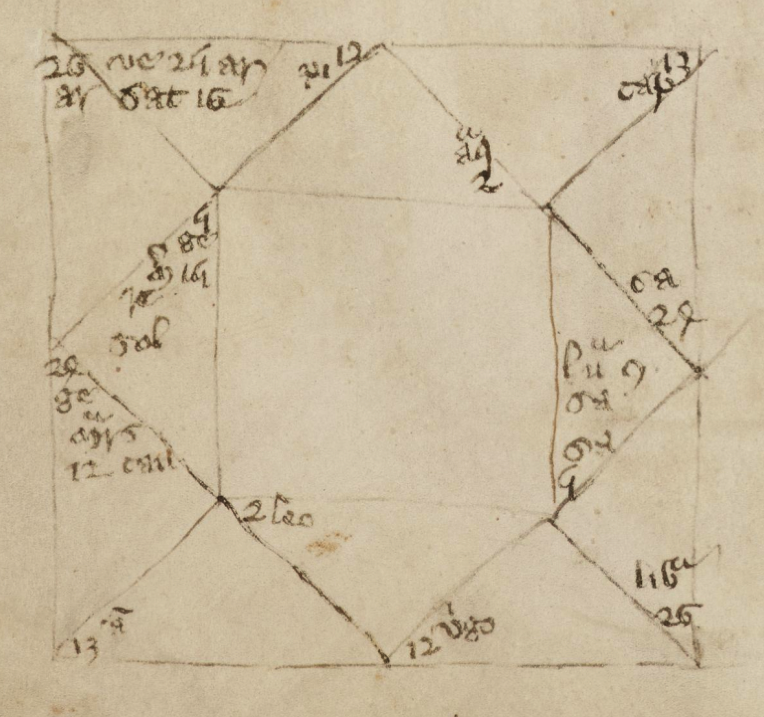
In the middle ages, the twelve houses were typically represented as twelve geometric divisions within a square. This form was still in use in the 17th century but was gradually superseded by the wheel-and-spokes style of chart. [Cambridge MS Peterhouse 75.I]
The positions of the planets are then added to each segment based on the time and location of the chart (volvelles were used to help calculate the positions), along with any constellations that have influence over that segment at the time. Specific planets and constellations do not always show up in every house or with equal frequency.
Astrology was a lucrative business. Manuscripts were hard to come by and those who owned books on astronomy that included charts for computing star positions could sell their skills to the nobility.
In a natal chart cast for King Henry VI in the 15th century (shown below), the sequence begins with Gemini in the first house, and Cancer in the 2nd and 3rd. Sagittarius is noted in the 7th house and Capricorn in both the 8th and the 9th, followed by Aquarius and Pisces in the 10th and 11th.
In other words, in a medieval chart, the sequence doesn’t necessarily start with Aries, as is typical of zodiac cycles, doesn’t necessarily include all the constellations, and sometimes repeats a constellation if the sign is in transition from one house to the next.
This method of plotting the positions of planets and stars might explain the peculiar arrangement of the VMS zodiac sequence. Imagine if you expanded out the twelve houses into twelve separate drawings rather than trying to fit them all into one grid.
To put it more simply, the VMS zodiac sequence might not represent a zodiac cycle, it might be an illustration of twelve houses and the sign that has the most influence within that house at the time and location for which the chart was cast.
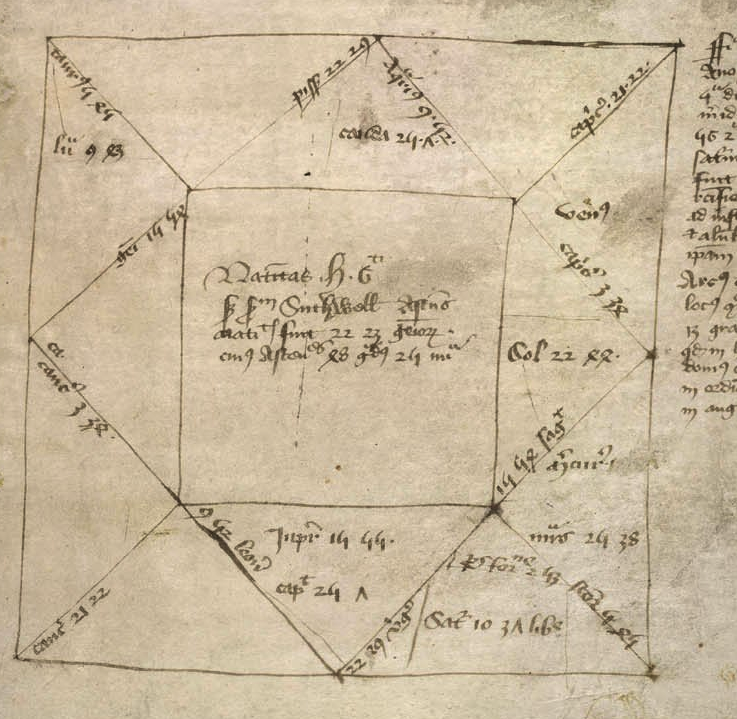
Medieval horoscopes are usually organized into geometric triangles within and surrounding a square. The name, date and time of birth (or of a specific event) are inserted into the central square. The houses usually begin in the triangle on the middle-left and follow twelve divisions counter-clockwise around the central square. This chart was drawn up for the birth of Henry VI (1421) in Cambridge, England. [Image credit: British Library, Eggerton 889]
Assigning Cycles to Houses
If the VMS zodiac folios represent an expanded natal (or other special-event) chart, it should be possible to identify the twelve houses by their subject matter.
The order of the houses doesn’t really matter. In less elaborate charts, they are identified by number, or simply by their position within a square as shown above. In the VMS, if the twelve wheels, taken together, represent a horoscope, it is a clever way to combine the meanings of the houses along with whichever constellation was visible in that house at that particular time—a two-in-one solution to schematic representation that makes it mnemonically easier to understand the houses.
Relating VMS Wheels to Traditional Houses
It’s not difficult to find commonalities between the VMS zodiac wheels and traditional descriptions of the astrological houses, but do they relate well if taken in sequence?
- First House—One’s life and physical form. The first VMS wheel appears to be a cycle of life, from birth to death as discussed here, so it matches quite well to the first house.
- Second House—Household and property. The second VMS wheel looks like a cycle of pregnancy to me, from childhood through puberty, to pregnancy and post-partum, which doesn’t seem to fit the second house’s relation to material goods and property.
- Third House—Kinship. The third VMS wheel has always looked like a medieval family tree to me, and the traditional third house relates to kinship and relations, so maybe this one matches.
- Fourth House—Ancestors and assets. Once again we have something that resembles a family tree and shows fancy clothing (material goods and assets). This relates well to the theme of ancestors and assets.
- Fifth House—Pregnancy and Procreation. I would have expected the second VMS wheel to be here, the one that looks like puberty > pregnancy > post-partum. The sixth VMS wheel would also be appropriate in this slot, as it has men and women together with the man’s genitals clearly drawn. Perhaps the fifth VMS fits, as it shows what appears to be a cycle of menstruation followed by a fat stomach (pregnancy?) followed by a more slender waistline, and there are men in this wheel, but I’m not completely sure.
- Sixth House—Illness and Calamity. The sixth VMS wheel has a high proportion of men and relates to romance and sex in both the inner circle (with the courting Gemini figures) and the images that surround it, so I can’t see any relationship here between the VMS figures and illness or calamity. The sixth wheel would fit better in the fifth house.
- Seventh House—Marriage. It’s difficult to see what is going on in this wheel because many of the figures are male but some of the male-like figures appear to have breasts added in darker ink in a style that is slightly different from the other female nymphs. It’s also difficult to know if this represents marriage when sex has already been shown in a couple of the previous wheels and there doesn’t appear to be as much sex going on here (some of my friends would probably joke that that is typical of marriage).
- Eighth House—Death and Murder. Death and murder is not a topic we frequently see in the VMS. Most of the nymphs are going about their business quite happily and the animals have paws instead of claws and never show any teeth, not even the one that vaguely resembles a lion. So, I’m not sure how to interpret the eighth VMS wheel other than to note that many of the nymphs appear pregnant.
- Ninth House—Journeys. What can I say, more nymphs, some of them heavily pregnant. It was mostly the men who went on long journeys… sailors, crusaders, soldiers, explorers, merchants, so it’s hard to know if this wheel relates at all to the ninth house.
- Tenth House—Authority. This is another wheel in which many of the figures look like they are male and where some of them look like they’ve had breasts added. A few have fancy head-dresses. It doesn’t overtly seem to represent authority unless it means medieval authority of men over women.
- Eleventh House—Friendship. The eleventh VMS wheel is a mixture of male and female nymphs (once again, some seem to have had breasts added) and there are four figures across the top with long hair, two with fancy headdresses. I can’t tell if this represents friendship. There’s nothing overtly indicating friendship other than the nymph top-right and the one middle-left (inner ring) who are touching the the nymphs beside them and this isn’t enough to know for sure.
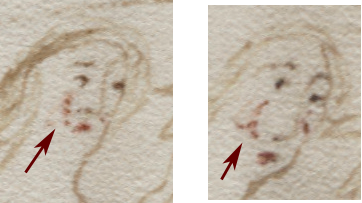 Twelfth House—Sorrow and enemies. Are these nymphs more sorrowful than others? Look at their mouths. Also, note that there are nymphs across the top of this one in the same manner as the previous wheel. If wheels 11 and 12 represent the yin and yang of friendship/trust and sorrow/enemies, they might conceivably be drawn in similar ways. Note how the nymph directly above the crossbowman has a line of red dots on her cheek, rather than the usual blotch of blush. One can sometimes find dots on the other nymphs, but not usually in a vertical line. I’m not sure if this is a sneaky way to represent tears or just an anomaly, so I’ll leave it to the reader to decide.
Twelfth House—Sorrow and enemies. Are these nymphs more sorrowful than others? Look at their mouths. Also, note that there are nymphs across the top of this one in the same manner as the previous wheel. If wheels 11 and 12 represent the yin and yang of friendship/trust and sorrow/enemies, they might conceivably be drawn in similar ways. Note how the nymph directly above the crossbowman has a line of red dots on her cheek, rather than the usual blotch of blush. One can sometimes find dots on the other nymphs, but not usually in a vertical line. I’m not sure if this is a sneaky way to represent tears or just an anomaly, so I’ll leave it to the reader to decide.
Implications
Many of the VMS wheels can be related to medieval astrological houses, and several appear to be in the right sequence, but is the similarity strong enough to support the idea? Let’s go back to the horoscope and see if there’s anything that can help confirm or deny this impression…
Looking at Henry VI’s chart, shown above, we see Gemini listed in the first house, Cancer in the second and third, “Leon9” (Leo), in the fourth, and so on, with Pissz (Pisces) in the 11th, and “Taur9” (Taurus) in the twelfth.
Thus, in King Henry’s chart, Gemini is first, Cancer and Capricorn are each represented twice and Aries and Libra are missing. Why is this? Because a natal chart is drawn up for a specific time and place. It doesn’t have to start with Aries, it starts with the person’s “birth sign” or ascending constellation. At the same time, some of the constellations may be transitioning from one house to the next, and others may not be expressly visible.
This is very similar to the way the VMS zodiac symbols are represented. The cycle begins with Pisces, not with Aries, and Aries and Taurus are shown twice, while Capricorn and Aquarius are not shown at all.
If the VMS zodiac-symbol sequence is a natal horoscope (or one for a specific event, like the investiture of a king), whose is it? Does it relate to the creator of the VMS or perhaps to a patron, or to one of the prominent individuals of the time? Or is it a teaching tool, to give an example of how a prognostication chart might be organized? Is it perhaps an example of “judicial astrology” in which a legal judgment for some infraction is said to be written in the stars?
Here is a simulation of the sky above Rome, Italy, at midnight on January 1st, 1408. Aries, Taurus, Gemini, Cancer, Leo, and Virgo are clearly visible and the others are outside our current point of view:
If we want to see how the sky might have appeared after Pisces came into view (for the same location) we have to look later in the year—around the end of November or beginning of December:
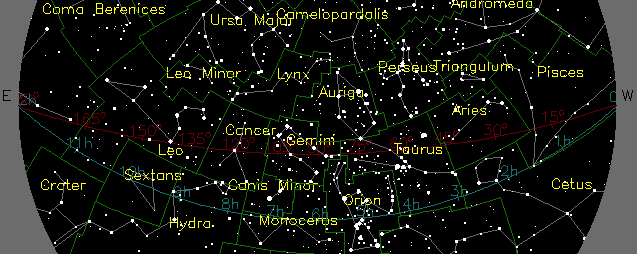 This, of course, will change as you go farther north or south (and east or west). For example, if you go south to Cairo, Egypt, and look up at the same time and date as the previous example, Pisces will not yet be visible.
This, of course, will change as you go farther north or south (and east or west). For example, if you go south to Cairo, Egypt, and look up at the same time and date as the previous example, Pisces will not yet be visible.
Summary
I’ve said this in the past, but wasn’t sure how to explain it in a blog before now, but I think the VMS sequence may be a horoscope, rather than a zodiac cycle or calendar. Many aspects that seem strange in the context of a zodiac cycle are not, if the entire sequence is viewed as the chart for a specific event. It would also be a credit to the VMS creator, if he or she found a unique way to pictorially combine the concepts of astrological houses with an “expanded” prognostication chart.
As a bonus, if the VMS zodiac series is a horoscope for a specific event (rather than a teaching example using arbitrary zodiacs) then, with a bit of computing power, it may be possible to calculate the specific times and places during which Pisces was rising, Aries and Taurus were on the boundary between houses, and Capricorn and Aquarius were not visible enough to be included.
Postscript [3 hours later]: I don’t know if I was clear enough about how I think the VMS wheels might relate to medieval horoscopes, such as the one cast for Henry VI, so I have expanded each of the sections of the Henry VI chart and added the influences of the houses, so they can be compared more easily to the VMS wheels. With the exception of the Gemini nymphs (which seems better matched to House 7 than House 6) and the 8th House (Death, Murder, Estate), the correspondence between the houses and the VMS figures is not too bad. You can click on the images to see them larger:
J.K. Petersen
© Copyright 2017 J.K. Petersen, All Rights Reserved. Citations: J.K. Petersen, 12 July 2017, voynichportal.com

